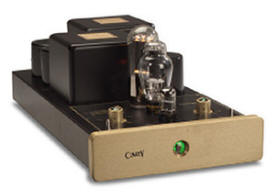You are reading the older HTML site
Positive Feedback
ISSUE
22
The Second Annual Positive Feedback Online's Writers' Choice Awards - for 2005
Beginning at the end of 2003, PFO established its first annual awards for fine audio. The Brutus Award was established for the best that Dave Clark and I had heard in our own listening rooms during that year. You can think of it as our equivalent of an "Editors' Choice" award.
The Gizmo Award, on the other hand, was established in memory of my very good audio friend, Harvey "Gizmo" Rosenberg, and is given by me to the most conspicuous audiomaniac(s) of the year. Only one Gizmo is given per year.
The following is an opportunity for our editors and writers to recognize superior merit in the audio arts though their "Writers' Choice Awards". Our writers and reviewers have been given broad leeway to cite excellence in fine audio wherever they find it: products, people, recordings, events, groups, etc., so that our readers can be better informed.
It is our hope that you will find the PFO Writers' Choice Awards to be helpful to you in your audio journey.
All the best,
David W. Robinson, Editor-in-Chief
|
John Acton |
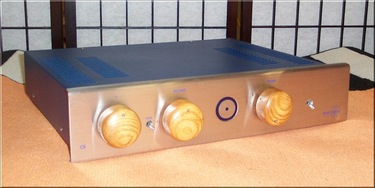
Blue Circle NSCS integrated
My first nomination for the 2005 Positive Feedback Online's Writers' Choice Awards goes to Blue Circle's outstanding NSCS solid-state integrated amp. Eschewing traditional cosmetics and circuit-board-based design techniques, the sound produced by the NSCS is something special. Resolving and transparent, the amp is an open window to the musical event, with remarkable soundstaging and recreation of dynamics. Possessing just a hint of bloom and warmth in the midrange, the NSCS successfully marries transparency with musicality, which, taken in total, proves to be utterly beguiling. I still miss having this superb performer in my system.
Acoustic Sciences Corporation Sound Panels
My second nomination goes to Acoustic Sciences Corporation (ASC)'s Sound Panels. Sold in packages of eight, these slender, unobtrusive acoustical treatments are designed to control flutter-echoes and other acoustical anomalies when strategically placed at primary and secondary reflection points in one's listening room. The Sound Panels flat-out take the performance of my system to another level. I hear improvements in soundstaging, clarity and naturalness, all of which allow me to listen longer with less fatigue. Their ease of installation and extremely reasonable price, coupled with the sonic gains realized, makes ASC's Sound Panels a no-brainer for recommendation.
|
Myles B. Astor |
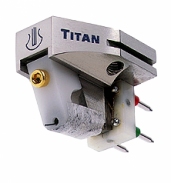
Lyra Titan i Moving Coil Cartridge
The newest Titan i is the world's finest analog transducer. Once broken in, the newest top-of-the-line Lyra cartridge tracks the record grooves like a Formula One racing car and exhibits vanishingly low levels of distortion. Now if tracking ability is the whole story, then the Shure V would be king. But there's a lot more to this cartridge than meets the eye. This latest thinking on cartridge design from Lyra's Jonathan Carr and Yoshinori Mishima offers the best balance of musical reality of any Lyra cartridge—and for that matter—any cartridge. The Titan i offers the ultimate in neutrality, resolution, dynamics (especially at the low end of the frequency spectrum), transparency and sheer musicality. Almost every record is an absolute treat. Review to follow shortly.
Best Rock Concert: U2 Vertigo Tour
Not since Fleetwood Mac's summer'77 tour has there been a better rock concert at Madison Square Garden. Two and a half hours (including two encores) filled with Bono and company accompanied by the sellout crowd singing along with their favorite U2 songs made for an unforgettable evening. Choosing a favorite, much less three favorite songs, was a near impossible task. That said, "Sunday Bloody Sunday, Desire and Vertigo got my blood boiling and my feet moving!
Best Original Digital Recording: David Chesky: Area 31 Chesky Records SACD288
Finally a digital recording—and a SACD at that—that doesn't require qualification–or apologies for its sound quality! David Chesky's continued refinement of both his microphoning technique and accompanying electronics resulted in digital recording with real pitch definition (especially in the low frequencies), markedly lowered digital distortion and a sense of real space rarely captured in digital recordings (save for a few times that I've heard the original digital recording). Couple this with Chesky's own unique blending of classical and jazz themes and one has all the necessary ingredients for a mouth watering, lip smacking audiophile and musical lovers audio gastronomic delight.
Best Analog Reissue: Schostakowitsch: Symphony NR.10, Berliner Philharmoniker (Herbert von Karajan, conductor), Deutsche Grammaphone/Speakers Corner 139020 SLPM.
As the saying goes, better late than never. This 12-inch black disc sat for several years on a record shelf due to DG's less than stellar reputation for sound quality (read unlistenable). Big mistake. This reissue bears little resemblance to the DGs that I'm and PFO's readers are familiar with (according to Sid Marks, and who's to argue with his years of experience, not all DG's records sound like a "table radio." ). This Shostakowitch's Symphony NR. 10 possesses an extremely wide frequency response along with a sense of hall acoustics and natural instrumental timbre (save for an extremely rare high string hardness). Yes, there's a glint of the Speaker's Corner's sound but that's more than compensated for by von Karajan's mastery of the 10th. Grab this album if it's still available!
|
Gary Beard |
In a year that has seen an inordinate amount of change in both my life and my audio system; reviewing equipment has taken a back seat to many more important things. However, there are a number of components I feel merit my anointment as special pieces of audio gear. To complicate matters, I have only written a formal review of one nominee and as of this date, I have penned nary a word about two of them. While this is undeniably unusual, I wanted to participate in PFO's "Best Of 2005" Writer's Choice Awards and knowing it would be an entire year before the opportunity once again presents itself, I have chosen to circumvent normal protocol and give these fine pieces of audio the nod. I find all these audio goodies deserve to be honored and in the case of the last two choices, waiting one more year would have made no difference. Their "technology" will not be subject to electro-mechanical or judgmental obsolescence…

The Slim Devices Squeezebox 2 Music Player
This little gadget decodes digital music files streamed from almost any late-model computer and plays them back though any audio system with digital or analog inputs. The Squeezebox 2 (which has recently undergone a redesign and christened the Squeezebox 3) is a convenience and value blockbuster. I haven't had as much fun with a new audio toy in years. But make no mistake, the Squeezebox 2--which has been cosmetically upgraded in the newest version while still retaining the basic electronics of the 2—is not just a computer geek's dream, it offers excellent sound for the audiophile as well. So whether you are looking for a music server to use as your main method of listening or just a convenient way to get background music around the house, you can't miss with this $300 dollar marvel of technology.
The Hsu VT12 Ventriloquist 5.1 Surround Speaker System plus STF-2 Subwoofer
If you are in the market for a space saving budget surround sound system that excels in a small room, the Hsu Ventriloquist system is a definite must audition. It gives the listener an astonishing amount of good sound per dollar and with the STF-2 Sub, its sonic performance leaps to the top tier of the mini home theater-in-a-box category. I use it in my 10' x 10' computer room driven by a Pioneer DV-578A universal disk player and a Panasonic SA-XR50. Movies certainly sound great, but this miniscule system is even more impressive playing multi-channel hi-rez discs. So if you are looking for inexpensive 5.1 speakers for a small apartment, den, cabin, or dorm room, check out the Hsu's, they sound terrific.
The Fi-Xi Passively Integrated Amplifier
What can I say that hasn't already been said about Don Garber's wonderful gift to the under funded tube-loving audio freak. While it does take some work to find the right partnering gear for this 3.5 watt tube amp, the little X is a gift from a talented designer to those of us who love music and enjoy owning a unique product in a cookie-cutter world. Stay tuned; more to come in 2006.
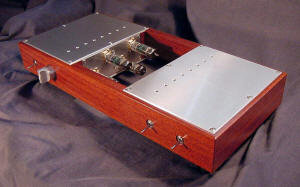
The AudioTropic Moebius Linestage
Ok, I admit it; Michael Lavorgna of 6moons beat me to it by proclaiming the Moebius one of his best of the year. He is dead-on; the Moebius is a killer linestage and Eric Kingsbury deserves to be recognized for his contributions to the art of building vacuum tube audio gear. The Moebius exudes a refined yet simple handmade elegance that belies its sonic abilities. There will be more to say on this subject in the coming months, but for now I'll just say that the AudioTropic Moebius now resides in my system and is not likely to return to the islands unless I am tethered to its frame. Aloha!
|
Larry Cox |
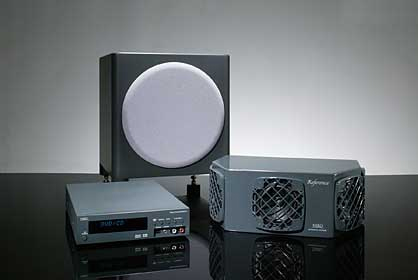
Top Five products I've listened to this last year: Niro Reference, about $1,000 buys an audio home theater with sound good enough for 95% of the audiophile world from a single subwoofer, one speaker box and a DAC/digital amplifier, that doesn't take over the house while delivering the theater to your house, stupendous value. Oritek X-1 cable; great sound without regard to price and only $200 a meter, how to argue with that? At the risk of seeming a hypocrite, the Benchmark Media Systems DAC1 performed all out of its price range, though I couldn't live with its presentation, it is still an extraordinary product.
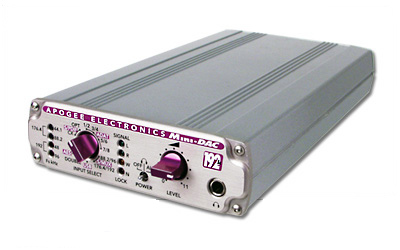
The Apogee Mini-DAC is a DAC I could easily live with, great tonal balance, more functionality than 99% of audiophiles can use, though it's attributes won't bite your leg with greatness as the DAC1 does, far more listenable over the long term for me. Ensemble Dirondo transport and Ensemble hi-DAC I could live with, want to live with, but don't have the scratch to live with this digital system—in the right system it is fabulous and will last you till retirement.
|
Max Dudious |
Max Dudious nominates two excellent (if costly) sets of interconnect cables for the Writer's Choice Awards—Harmonic Technology's CyberLight photo-optical cables, and Silversmith's Palladium cables. Coming from opposite directions each achieves a higher level of excellence with slightly differing characteristic sound. See detailed reviews: https://positive-feedback.com/Issue17/cyberlight.htm and https://positive-feedback.com/Issue21/max_silversmith.htm. Silversmith's Palladium interconnect and speaker cables are an example of what can happen when a good engineer (Jeff Smith) brings his insight and talent to a new audio-material, the metal Palladium: and, in service to the particular needs of audio, applies his know-how to make new, audio-dedicated products. His palladium alloy has skin effect conductance qualities that are, he says, 25 times more effective than any he's measured. The result is a set of cables that spec great and sound great, that exhibit minimal time smearing, which makes for a near optimal approximation of a live, "in the room" event. With sweet highs and a palpably liquid midrange, this sometimes startling facsimile of the original musical performance brings to the listener an illuminating sound with exceptional warmth and few tradeoffs.
Harmonic Technology's CyberLight interconnect cables are an example of a wholly new (to audio) technology, fiber optics, and its application to audio after a century of metal cables. By using glass to conduct the audio (converted to pulses of light), fiber-optics sweeps away nearly all the problems of a metal signal carrier that might exhibit time-smearing—metallurgy, capacitance in insulation, geometry of the lay of the filaments—all the resistance, capacitance, and inductance (or the "rcl" variables) of each foot of cable that comprise a tuned circuit. The result is a generation of flat-frequency-response cables, free of tuned circuits, that also make for an astonishingly convincing "in-the-room" illusion due to their unusually superior definition. Truth teller Jim Wang and his gang have brought us a cable that is a tad dry in comparison with the Palladium cables, but a cable of exceptional clarity and minimal time-smearing. With its extraordinarily wide band and detail, the CyberLights offer the listener lifelike reproduction and emotional involvement with few tradeoffs.
|
Francisco Duran |
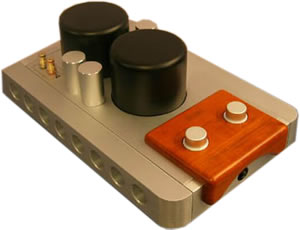
Qinpu A-8000 Mk. II integrated
They say that once you go tube you don't go back. While it is true that the tube bug hit me hard some years back, there is a new amplifier in town that could bring me back to playing in the sand with no apologies whatsoever. The seductress in question is the beautiful Qinpu A-8000 Mk. II solid state integrated amplifier. With 100 watts on tap and four inputs this class A/AB unit is ready to play music with minimal set up. The Qinpu paints a very smooth, clean and dimensional sonic picture. Yet it doesn't short change you in the way it handles the tone, color and to a certain degree the midrange bloom of musical textures. Add to these qualities a spacious presentation that rivals tube gear and you have an amplifier that adds up to hours of music making. Along with its gorgeous exterior, excellent build quality and silky smooth controls, what more could you ask for? This amp is one "solid" argument in favor of permanently jumping off the gear merry-go-round be it tube or solid state for a long musical ride!
|
Srajan Ebaen |
With five submissions per writer, I decided to focus on one vote per category and limit myself to items I purchased for my own enjoyment this year. For speakers, that would be the Zu Cable Definition Mk1.5, a $9000/pr 12" x 12" x 48" compact statement speaker that does 16Hz – 20,000Hz at 101dB, with no crossover between 40Hz and 12kHz, 4 self-powered rear-firing 10-inchers and two paralleled, in-house designed and built wide-band 10" drivers and horn-loaded tweeter upfront. This is the ultimate speaker for micro-power SET fiends. A new passive version for bi-amp scenarios has just been introduced that adds the Rane PEQ 55 for sub 40Hz bass management. This speaker has it all—infra bass, dynamics, crossover-less immediacy and tone. Possibly the most bang-for-the-buck speaker on the market right now. Just one man's opinion but I voted with my wallet.
The $2495 (introductory) Music First Audio Passive Magnetic is built by Stevens & Billington and then sold under their subsidiary brand. Four single-ended and two balanced inputs, selectable RCA or XLR out, ground lift, +6dB gain switch and completely passive, transformer-based attenuation have garnered this piece an Editor's Choice and Best Preamp of 2005 with a UK magazine and rightfully so—SET devotees with enough gain in their systems to call additional preamp gain redundant will marvel at the reduction of system noise and ultimate transparency that now lets their amplifier shine forth without ‘interference'.
The $3000 (with Emission Labs solid-plate 45) Yamamoto A-08S is an absolutely flawless marvel of all custom parts, superior cosmetics and ultra-modern high-resolution sound with zero noise and monster tone. While 2 watts necessarily limit its appeal to a very narrow niche audience, those with ultra high-efficiency speakers simply must look at this amp before they spend 3 times as much to get a lot less.
The $1800 Patek SE by AudioSector DIYer Peter Daniel is a 50/100w stereo/bridgeable "Gainclone', meaning an op-amp design. Ultra-dynamic, fast, transparent but endowed with tube-reminiscent image density, this is a sand amp tube fossils like yours truly will dig. In fact, I bought the very first pair ever built. Matches like first love with the ModWright Audio SWL 9.0SE tube preamp.
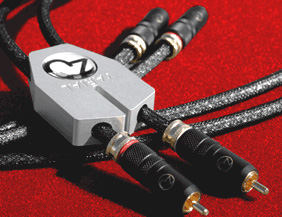
The $495/pr Zu Cable Varial is the best and most expensive interconnect this Utah-based company makes. It's a premium cable within spitting distance of the $5750 Stealth Indra. In my book, there's no need to spend a penny more on cables. Ditto for the matching Zu Cable Ibis, a $1,200/8'/pr speaker cable. Both are based on the company's proprietary B3 geometry and offer ultra-low noise floors and premium resolution for systems that can handle that amount of magnification power.
|
Rick Gardner |
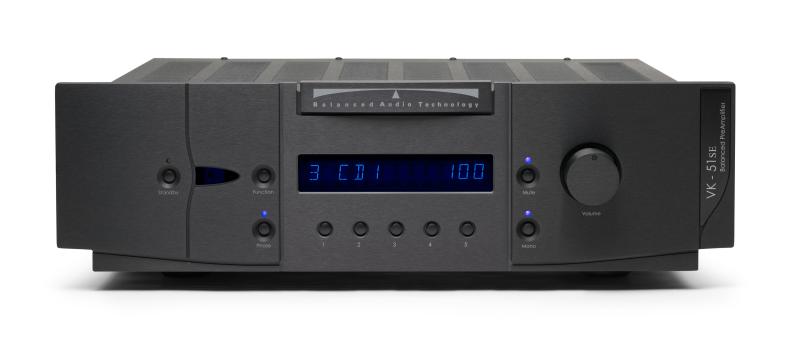
Balanced Audio Technology VK-51-SE tube line preamplifier (MSRP - $8500 + $500 for the remote option)
Balanced Audio Technology Vk-600-SE solid state, power amplifier (MSRP VK-600 base price - $7995. VK-600SE {Special Edition - includes the BAT-PAK and Super-PAK options.} $11,500)
Jena Labs Valkyre balanced interconnects & speaker cable (MRSP $3000 - initial three feet, terminated. $230 per foot additional)
Reviews in Progress
He's baaaaaaaaaaaaaaakkkkk!
After an extended hiatus, while I basically lived out the worst parts of the Old Testament, I am back; scarred, bloodied, but unbowed. Dennis Miller got it right. Life is occasionally like a grizzly bear set lose in a crowded campground.
I thought it both appropriate and symmetrical for Dr. Sardonicus (the somewhat unflattering moniker David hung on me after observing I sometimes wield an "intercontinental ballistic pen") to re-emerge by returning to the site of the original crime. My first reviews for PF were of the BAT VK-5-i line stage and VK-500 power amplifier.
My current review series will run the gamut (Gauntlet? Hum, so often so similar) from a revisit to the luscious Cardas Heart MC phono cartridge through the BAT VK-P-10-SE phono-stage, to perhaps even a prototype of a world-class debut speaker from the hands of Jennifer Crock. However, the writer's choice awards have come around too soon for a completed review.
As reluctant as I am to make and to stand by rapid-onset, kinesthetic judgments about audio and music, wait ...no that's someone else. I am actually quite willing to do that.
Music is about the body and the body knows. Show me a gaggle of audiophiles calmly dissecting a system using politically correct techno babble, and lo, it is because music be not in the room. Show me the same group raucously demanding to hear the Bobby Fuller Four ...admonishing the host to turn it UP ...and shamelessly braying for more ale (or more snifters of really old Armagnac ...uh, sorry Jonathan), and yeah, verily ...the music be upon them.
So, here we go...
The BAT pieces are easily the finest amplification chain I have ever heard; period. The VK-600-SE simply has no shortcomings, none. Transparent finesse, silky smoothness, confident refinement, and virtually limitless power and dynamic range without compromise of any sort, BAT may not be enjoying the "boutique" chatter directed towards lesser pieces, but forget about fashion and listen to these two extraordinary components TOGETHER and listen to them balanced. Running BAT gear single-ended is like putting Bridgestone tires on a Ferrari.
AND, hook them together with Jennifer Whitewolf-Crock's cable (aka, Jena Labs).
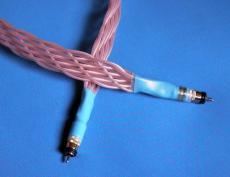
The Valkyre is the "best bang for the buck" level of Jena Lab's peerless, handmade products. There is no neurotic audiophile foo-foo here. What you get is absolute state of the art design and engineering, the finest materials available ...cryogenically treated and lovingly hand-assembled by the designer herself. This is true artisanal audio. Simply astounding.
I will confidently put this combination up against anything out there, for any amount of money, AND driving any speaker load you might care to toss in.
Raise your eyebrows if you choose. Snort if you must. Then go and listen. No weenie cables, no single-ended adaptors. No carefully constructed euphony. Prepare to be dazzled. From Bruckner to Bella Fleck ...and yes, even Bobby Fuller Four ...this is hifi.
|
Roger Gordon |
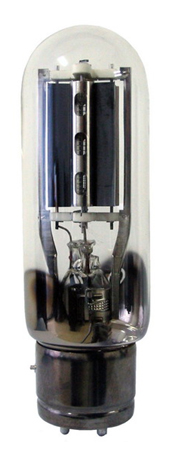 Super-TNT 845C (formerly 845M) vacuum tubes
Super-TNT 845C (formerly 845M) vacuum tubes
Tube rolling is fun and a great way to improve the sound of your tube gear. Unfortunately, NOS power tubes can be very expensive. A matched pair of NOS RCA 845s will set you back almost $1,000 and a matched pair of NOS United 845s even more. I just did another comparison of the Shuguang 845C tubes that I purchased through Super-TNT. This comparison was done against two pairs (with different internal structure) of NOS United 845s and a pair of NOS RCAs. A previous comparison was done as part of a review of the 845C in PFO 17. The results of this new comparison confirmed in my mind that the Shuguang 845C is the sonic equal of the NOS RCA 845 at a fraction of the cost. Anyone who is bringing to market a current production power tube that equals the best of the NOS tubes certainly deserves an award.
Universal Record Stabilizer Ring
The URSR is a periphery ring that fits on the outer edge of an LP. It is compatible with virtually all platters and tonearms, except the Triplanar. When I reviewed the URSR in PFO 20 I had played scores of LPs using it and thought it made a measurable improvement to the sound of my vinyl playback system. I have now played hundreds of LPs using the URSR. In my mind the URSR is absolutely essential. It flattens minor warps, the sound comes out of a blacker background, instruments within the soundstage are more solid, more real, and and there is more stability to the images within the sound stage. I never play an LP without the URSR in place. An essential accessory for every turntable.
|
Clark Johnsen |
My top five choices for the year? You're asking me? Oh, my. You know I don't do reviews. How embarrassing. Now I have to come up with something.
OK, sure, I've covered the RealityCheck CD duplicator. It's great! Also, two fluids from the same supplier, ClearDisc and ClearBit, to prepare a CD for recording or play. You're nowhere without them, although reportedly one other may be just as good. And Optrix is far and away the value winner at $16, but that would be my Number Six, so forget it! Anyway, it's of an older generation.
This year cannot be allowed to slide by without a mention of its most controversial entrant, the Intelligent Chip. While there is no doubt in the minds of hundreds of audiophiles that the effect is real, however baffling, it continues to be a topic for agonizing among those who don’t care to listen.
The ER Harmonizer has received no notice whatsoever in the press. It’s a lightweight wooden board made of 100-year-old cypress that you place under your stuff, and while it doesn't always work, it does come from Russia, which makes it exotic and wonderful. The site is a beaut: http://eraudio.com/
Sports and speed are represented in audio by Lloyd Walker's Extreme SST, a contact conditioner you should go the distance for. Don't forget to do your fuses and your circuit breakers.
Speaking of which, I'm looking for high-end models of the latter. Anyone?
Finally, seriously, to suggest something more regular: Harmonic Technology CyberLight interconnects. These really work! Especially with the battery supply. I don't know what it is. The absent galvanic link? The insusceptibility to EMI/RFI? The indifference to length? Something! So the measurements in Stereophile uncovered a frequency response anomaly—in cables no less. Was I surprised? Frankly, no... and, yes. Talk to me about it at the party.
And now, announcing in advance one of my Awards for 2006, as this shall surely come to pass (and remember where you read it first): The Memory Player™ from the Nova Physics Group: "The old fashioned way of playing CDs is now just a Memory." This year the world saw an astonishing and unexpected development, the most advanced CD playback technology ever designed, at the same time a wholly natural evolution. The Memory Player™ employs a CD playback principle known as "Read Until Write"™ (RUW), alternatively known as "Read Until Right"™ (RUR). (The designers claim no reference here to robots or petons.) Thus it is both a real-time player and a high-end CD burner that plays, and inscribes, nearly 100% of the exact data, far more than normally captured by even the best players of 2005. It boasts an internal CPU and vacuum tube analog sections, and sonically it beats the pants off competition.
In addition there are several upgrades, the most interesting of which enables extremely high quality digital recording from analog sources. Now you can convert your precious vinyl, tapes, or FM broadcasts to either CD or DVD Audio with ease. What’s not to like?
|
Danny Kaey |
2005 can best be described as a "tweak" year, what with a review of an audio/component rack, power line conditioners and jewel-like power chords all grabbing my attention in various ways. On the other hand, digital received an upgrade the likes of which I hadn't believed was possible, as just about all digital sources I had access to paled in comparison to the mighty Brinkmann setup. Naturally, when Dave emailed us to submit our personal "Best Of" choices for the year, I was a juggling all sorts of components in my mind, but ultimately settled for the following two:
 Alan Kafton of Audioexcellenceaz has truly outdone himself with the
latest generation of his PowerWing 6 outlet power line conditioner. Double-cryo'd, with the most jewel-like of all receptacles I have ever
seen, sourced by Japanese Oyaide, and a build quality that is simply so
far ahead of the competition not to mention esthetics, the sonic
improvement this component provided for was nothing short of
staggering. While my system sounded great without any line filtration,
adding a PowerWing catapulted the system to yet higher planes. Resolution, effortlessness, soundstaging and dynamic slam were suddenly
that much more obvious. Add to that the fact that Alan's product
undercuts the competition (hey, what competition?) by a 2:1 margin and
you have yourself a no-brainer. A full review is due shortly, stay
tuned. (review)
Alan Kafton of Audioexcellenceaz has truly outdone himself with the
latest generation of his PowerWing 6 outlet power line conditioner. Double-cryo'd, with the most jewel-like of all receptacles I have ever
seen, sourced by Japanese Oyaide, and a build quality that is simply so
far ahead of the competition not to mention esthetics, the sonic
improvement this component provided for was nothing short of
staggering. While my system sounded great without any line filtration,
adding a PowerWing catapulted the system to yet higher planes. Resolution, effortlessness, soundstaging and dynamic slam were suddenly
that much more obvious. Add to that the fact that Alan's product
undercuts the competition (hey, what competition?) by a 2:1 margin and
you have yourself a no-brainer. A full review is due shortly, stay
tuned. (review)
Schaffhausen, Switzerland, is perhaps best known for being home to the International Watch Corportation, IWC, a superlative swiss watch manufacturer. To those of us who are also into high quality music playback, you now may add Alan Wright's Vaccuum State to the map. Allen has been modifying Sony CD and SACD players for some time now, alas, it was only fairly recently that I had become accustomed to his fine work in the field of digital conversion. Since my mighty Brinkmann took place as the main music source in my house, digital has led a sorry life in these same four walls. Time and time, I proved to myself and others that no digital simply stood up to the delicacy, refinement and effortlessness of the Brinkmann setup. Then, almost out of nowhere I received Allen's latest Level 5 modded Sony DV-P9000ES DVD/SACD player. In complete disbelief, I sat through many listening sessions warming up to the fact that digital ain't so bad after all, and that DSD is simply the closest to analog we have. The modded player took digital in both redbook and SACD form to levels I could only dream of—so much so that I am finally at a point where I actually enjoy listening to digital. Simply the best digital source I have ever heard, period.
|
Mark Katz |
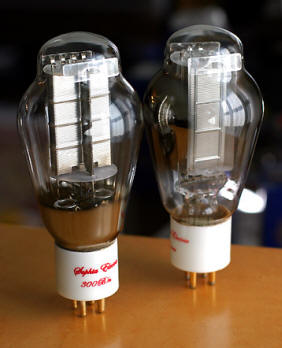
For the Do-It-Yourselfer, I'll start with parts. Single ended triode amplifier sound is tricky. Everything makes a big difference. Output tubes and coupling caps are two of the easiest things to change. If one uses standard 300B replacements instead of the new higher current 300B-like tubes, the Chinese made Sophia or TJ Mesh plates can't be ignored as among the best sounding current production 300Bs. The Sophia's Mesh Plate Globe type 300B has the quintessential old fashioned triode sound that many 300B fans crave. In my Tango transformer based 300B amps they have a warm, rich liquid midrange, smooth , delicate and a bit rolled treble range and full bodied bass. I really enjoy them. Sophia's new handmade Princess 300B uses a reinforced grid in a ST style enclosure. Start with the Mesh plate globe tube's sound, restore the treble, slightly focus the mids, extend and tighten the bass and you'd get the sound of the Princess. Unlike the Globe type which sounds good quickly and then gets better, break in is slower and critical. At first the tube seems a bit lean and not emotionally involving, but over a few weeks to a month of heavy use, the sound opens up to a better balanced rendition of the Globe type 300B. I can recommend both on a taste dependent basis. Since these come from the same company and are more variations on a design, I'll count this as one selection. (
After experimenting over the years with a variety of coupling caps in these SE amplifiers, everything from paper/oil, copper/oil, silver/oil, a variety of polypropylene caps, I've found two that work very well musically not losing detail or adding harshness. A descendent of the Infini-caps, the TRT Dynamicaps seem to do it all. They have excellent detail, superb midrange texture, smoothness, dynamics, and frequency extension.
The other is the VH Audio's Teflon V-Cap. They have amazing transparency, even more so than the TRT, and just shy of the TRT's tonal perfection in the mids. Both these capacitors have absurdly slow break-in. Think months. In a few weeks they sound pretty good, but it takes hundreds of hours until one hears what they're really doing, including the bass taking on greater definition and energy. Patience is well rewarded with either capacitor. I'm actually running one amp with the VH and the other with the TRT and will make a decision in the next couple of months which one will stay. Tough choice!
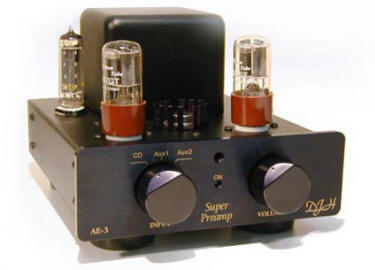
I'm coming to believe that a good preamp may be harder to design than a good amplifier. For those on a not exorbitant budget I have two suggestions from units I've tried this past year. For $1,200 to $1,500(with remote), the AES-3 DJH edition is from Cary's poor man AES division which serves to experiment on a budget. It is, as Kevin Deal of Upscale Audio puts it, a "hot rod". I think he means in the sense of an inexpensive automobile souped up to outrun the competition. Having limited features—one output, 3 inputs, on/off switch on the back, exposed tubes on top, this tube rectified 6SN7 based preamp gives a lot of performance for the money. If you want, you can have a remote control with mute and volume control($300). High quality parts are hidden inside the humble, small, and rather nice looking chassis. Dennis Had made a classic, no feedback tube design with better than expected bass extension, perhaps due to being directly coupled. Sound can be tuned by picking your 6SN7s.
Another candidate is a full featured linestage preamp with a modern sound is the Modwright SWL 9.0 SE. It has 5 inputs, 2 outputs, tape loop, home theater bypass, a handy remote for mute and volume. Its circuit is based around a pair of 5687 tubes. I found it amazingly quiet, very dynamic with, strong, well defined bass, articulate mids, good sense of space, and tonally very well balanced. I was never tempted to tube roll. Leave the Tungsol 5687s alone and enjoy. The nicely built and solid looking Modwright approaches the sound of the best at a much more affordable $2,200.
|
Ed Kobesky |
PrimaLuna ProLogue Two integrated amplifier
Want the magic of tubes without any hassle? Look no further. This gorgeous and impeccably built amp, imported and sold exclusively through Upscale Audio, will give you that—and a whole lot more. Unlike many budget-priced tube amps, it's not overly warm. Instead, it paints a detailed and coherent sonic picture that's astonishingly human, expressive and open sounding. As I said in my original review, I'd have no qualms about pairing it with loudspeakers and sources costing many times its modest $1345 price tag. It's not just a great tube amp, it's a great amp, period. In my view, it's also the most significant integrated amp to land on our shores since NAD's original 3020.
Alegria Audio Ling bookshelf loudspeakers
They're not the last word in anything—but at $349 a pair (recently reduced from $399), you wouldn't expect them to be. However, these hand crafted, magnetically shielded stand-mounts do a remarkable impression of floorstanding speakers with their giant soundstage and shockingly deep, tight bass reproduction. Highs sparkle though the midrange is somewhat recessed. The resulting balance is not unlike that of a good moving coil phono cartridge: airy, spacious and dramatic. The small batch Lings have a true "craft-brewed" look and sound that may not appeal to everyone, but those who've been seeking big box sound from a compact speaker will find much to love here at a ridiculously affordable price. (review)
|
Mike Lavigne |
Last Janurary at CES I was privileged to hear a very special prototype preamp from Herve Deletraz of darTZeel fame. The few of us that heard this 'ugly duckling' connected to Herve's magical NHB-108 amps thru the Von Schweikert VR9SE speakers were quite taken. It was a 'reference-busting' tease that caused me to re-think my system direction in anticipation ...even knowing we might not see the finished product for a year.

Well ...Herve being Swiss ...it didn't take a year. About a month ago I was privileged to be able to spend time with a pre-production version of the real thing. This darTZeel NHB-18NS preamplifier with phono stage is beautifully built and has completely changed my personal references for preamp and phono stage performance by a wide margin. In AC mode (when plugged into the wall) it is better than any other preamp I have heard. In battery mode it is 'other-worldly' good. If you hanker for (beyond) the State of the Art level of performance and are willing to pay for it; you gotta hear this. There is already a line-up of buyers that have ordered and paid for this product (including me) without hearing or seeing it. I easily choose the darTZeel NHB-18NS Battery Powered Preamplifier for a 2005 PFO.
I loved my Kharma Exquisite 1D speakers; but they just could not energize my new, large (29' x 21' x 11') room. What's a guy to do? Where do I find a speaker with the considerable strengths of my Exquisite's (clarity, coherence, non-hifi sound and a sense of listening to the event instead of a speaker) and yet give me more dynamic energy, deep bass extension, and truly give me that same intimate sense of immediacy I had loved with the Exquisite's in my old smaller room? The Von Schweikert VR9SE looked like they might be able to do all those things. After spending the last 6 months with the VR9SE's I can confidently say that they do all those things and more. Along the way I found that the VR9's were like an open window to everything in my system and the room. I have never had any piece of gear that was so revealing of every tiny performance change. I kept thinking that I was bumping up against a performance characteristic or limitation of the VR9's, only to discover that either my amps and passive pre were not synergizing, or my rack system was robbing detail and causing congestion, or my power cables were limiting bass articulation and coherence up and down the frequency range, or my speaker cables (you need two sets) were not doing the job. To this 'open-window' add the adjustability of three tweeters each with their own attenuation and a 1000 watt class 'D' subwoofer with gain adjustment and you have a speaker that has unlimited capabilities and also will challenge your system and set-up abilities to the maxx. The payoff is the best overall performance I have heard from any speaker. Therefore I choose the Von Schweikert VR9SE for a 2005 Positive Feedback Online's Writers' Choice Awards
|
Robert H. Levi |
My first selection for best of 2005 was around in 2004, but has evolved mightily in 2005. Cudos to the ModWright Sony 999SE CD/SACD/DVD Player Version 2. It has a powerful new power supply, very cool new capacitors, and numerous other tweaks from the genius of Dan Wright, CEO of ModWright. For less than $3500 including the stock player, you can more than knock on the door of the ultra highend and get the added benefit of a superb tube output stage, too. Unlike other tube designs, Dan uses inexpensive and plentiful 5687's which are readily available in top NOS pairs for $50 or less. Even the link between power supply and transport is a very special cryo silver cable provided in the complete mod. I love it placed on the Townsend 3D Seismic Sink and with Kimber Palladium AC cable on the power supply. Put any top AC cable on the transport [it takes 2 AC cables.] Just because the cost is relatively low and it does not give you DVDA, don't think it's a wimp. I heard it best players costing $12K in my system and provide a musical experience similar to LP playback. Better move quickly on this as Sony has discontinued the 999.
All four of my remaining best of 2005 Selections are from the amazing wizards at Harmonic Technology. They include the fascinating state of the art CyberLight Interconnects, the hot new lower cost Pro-Silway IIII Interconnects, their latest top of the line Magic Tweeter Loudspeaker Cable, and their take no prisoners fabulous all silver Magic AC Cables. All of these "ancillaries" can make as big a difference sonically as an equipment change and may be a superior choice to upgrading your gear! They are certainly among the year's very best tweaks I know of.
What treats! The CyberLight Interconnects are so low in coloration, I can't define any. System matching is important so use your dealer or call Harmonic Technology personally for correct voltages and models. You will be mightily rewarded. I hate it when I have to pull the CyberLights when I test out other brands. I put them back in my system when I listen for pleasure!
Want a great deal in interconnects? Try the highend bargain Pro-Silway III ultra low capacitance cables at under $500 per pair. With inner definition galore, they are amazing for the price! In my humble opinion, they best all comers in musicality and neutrality under $1000 per meter. Need lots of breakin, but WOW! They do not appear to be system dependent and will show you musically how terrific well made cables can be.
The Magic Tweeter Speaker Cable is for speakers that do not require bi-wiring. They are perfect for Avalons and the like with super low coloration and tons of inner detail. They cost less than half of many ultimate competators and sound just as good! Again, let them breakin well, but sound lovely from the start.
Last but far from least is the expensive Magic Silver AC Cable from HT. As flexible as a steel pipe, they are built like battle ships. They were superior sonically used with amps and AC power conditioners to my Kimber Palladiums and ALL other brands I could find for comparison. Less amazing on low votage gear like preamps or CD players. At $2000 each, one or two of these is a gracious plenty. These are the state of the art for ultra high end high power connectivity to AC. Way to go Harmonic Technology!
|
Karl Lozier |
This has turned out to be a most unusual year for me. Actually rare is more accurate. I probably averaged adding one or two new components (I consider cables to be components) every two years or so to use in my main two channel reference system. Being very used to my "unchanging" system usually allows me to quickly and often correctly do a preliminary/screening evaluation for possible review purposes. It started innocently enough at the CES in Las Vegas. It ended with all these components being added to my reference system. While checking out new products at CES for possible review articles I, "got the bug" to try to find a pair of new loudspeakers, specifically for my personal use. The well-known designer of those loudspeakers led me, with editor Dave Robinson's previous article helping, to the relatively unknown, but absolutely outstanding upgraded SACD/CD player. The cables listed arose because of my personal response to new companies almost shamelessly promoting new products with scientific sounding claims of new discoveries. The result was a plethora of reviews touting more "best cables" than imaginable and almost destroying review credibility while doing so. So that you have an idea of "where I am coming from", I believe in trying to not significantly exceed $5000 for a stereo pair of anything (such as a stereo amplifier) and with an absolute maximum limit of approximately $5000 for a single unit (such as one of a pair of mono amplifiers). Those $10,000, $25,000, or $30,000 components are seldom worth that much on a logical reasoning basis (and commonly have an identifiable sonic signature which is not neutral). Large loudspeaker systems, for large rooms, I could consider to be exceptions. I am a value oriented quality lover personally and usually in my review product choices.
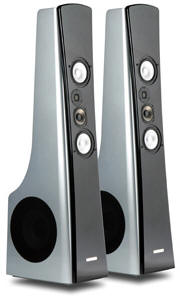 Genesis
G6.1 Loudspeakers
Genesis
G6.1 Loudspeakers
Absolutely full range rated from 16Hz to 36kHz! Each attractively styled cabinet, available in many finishes, is loaded with high tech drivers. The two small (for better dispersion) patented ribbon tweeters are mounted front and rear and in some respects may be unsurpassed. The midrange unit is perhaps unique in being a true titanium cone-a very light, very strong (non flexing) material. When you read about titanium-oxide drivers or cones, that simply means a coating on a regular cone. There is also a pair of aluminum 6.5 inch so called mid-bass coupling drivers also mounted on the two-inch thick front baffle, which has a small degree of back tilt. The titanium and aluminum cones radiate freely to the rear adding a distinct amount of spaciousness. Two twelve inch ribbed aluminum subwoofers-yes, subwoofers are mounted in the slim cabinet sides fed by 500 watt switching amplifiers in a high speed servo control circuit—an Arnie Nudell specialty that typically outperforms other seemingly similar setups. Though relatively tall, the slender wood cabinets are beautifully styled and finished and simply do not appear bulky or heavy. Spouse acceptance factor appears to be very high. To top off the high tech design by the acknowledged master Arnie Nudell, he so wisely added adjustable level controls to all the drivers except the so-called mid-bass couplers, being the reference. Hurray, I am so tired of manufacturers telling me that adjustments are not really needed—hah—maybe not in a perfect world or a perfect room. So satisfied, I could not resist purchasing. Warning, they can be extremely revealing (though adjustable) while offering high quality plus value pricing, as well as beautiful standard wood finishes (review).
VSEI Upgraded Sony DVP-9000ES Level 5
Allen Wright's Vacuum State Electronics, Inc., superb upgrade was mentioned last year by editor David Robinson as version Level 4. It was compared very favorably to his personal and very expensive reference player. I have no idea if this latest Level 5 upgrade eliminates the gap in sound quality he heard. I can tell you that it is noticeably and definitely superior to my two previous reference players, each at approximately $6,000. Purchase of a used Sony player plus installation of the VSEI upgrade module should run little more than two thousand dollars. At that price, it is beyond great value and approaches steal. A sense of great detailed clarity plus a beautifully smooth and sweet extended top end response characterize this over performing player. At least comparable performance would be available from other two channel only SACD/CD players from Sony's earlier releases; all are now discontinued. The other upgradeable U.S. models are the SCD-1, SCD-777ES, SCD-XB940QS and the SCD-C333ES, a multi-disk changer. None are multi-channel and only the DVP-9000ES includes video. The superb VSEI Level 5 upgrade model is not adaptable to any other player as of this writing. My sample upgraded Sony DVP-9000 ES Level 5 model's performance was significantly improved using moderately priced isolation accessories such as models by Bright Star Audio.
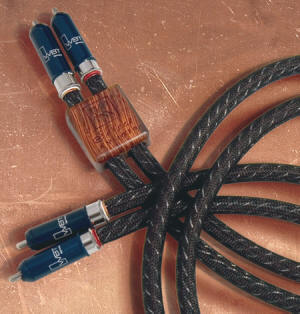
Kimber Kable Select interconnects
The Kimber Kable Company, after many years, still enjoys the reputation of having the world's largest and best audio cable research department. Thorough research and development has resulted in cables not needing regular updates or changes. Only two of these three models have ever been changed. They make claims that can scientifically be proven. These interconnect cables differ only in the metal conductors used. The model KS 1011 features only copper conductors. The model KS 1021 has only silver conductors in the signal side and only copper conductors in the return side, making it a hybrid model. As might be expected, the KS 1030 features high purity silver conductors for both the signal and return conductors. The all copper, KS 1011 had a full rich sound quality with a very sweet and smooth top end. The all silver model, KS 1030 provides a significantly tighter and overall more detailed sound. Bass impact and overall, the entire audible range demonstrates a probably inherent silver conductor quality. This quality is an almost palpable leading edge with a more dynamic impact and is very apparent with the KS 1030. The hybrid KS 1021 offers a sound quality that lies between the all copper and the all silver models, though much closer to the very detailed response of the more expensive KS 1030. The KS 1030 has become my reference interconnect. (review)
Herron VTSP-2 preamplifier
This might be "the sleeper product" in audio electronics. Many years were spent in development while trying to improve on the original Herron preamplifier. After finding further audible improvement to be unattainable, Keith Herron turned his attention to requests for features. The previous model eschewed features because many are known to affect ultimate performance. While making certain that there was no audible degradation created by adding any new features, he discovered that some of his preventive cures actually slightly improved overall audio quality. Quoting my full review, "the VTSP-2 amplifies signals with no audible alteration or degradation." Its only competition is to be found somewhere in the $10,000 to $20,000 range. Many of those evidently deliberately feature a definite audible signature, possibly to elicit responses such as "wow—hear that bass!" The Herron reveals all as it is fed to it—no more and no less. Available in silver or black chassis, a small remote control is provided with either. Automatic turn on muting and a very visible and accurate volume indicator is useful for repeating output settings. Other features are more performance oriented. The gain/volume control is not notable for its linear performance. When asked why he chose it, he replied that it is simply the best sounding control that he has been able to find. Sound reigns over all others. The relatively lightweight Herron preamplifier's performance can be slightly improved using isolation products such as Bright Star Audio's Reference Isolation model. Tube selection is kept on record by Herron for possible matching. Swapping tubes is definitely not recommended—not even for rare, famous or very expensive brands. This preamplifier, with its highly revealing and exactingly neutral sound quality, has become my personal reference and I expect that to be true for a very long time. (review)
|
Sasha Matson |
Cary Audio CAD-805 Anniversary Edition mono amplifiers
These single-ended triode monoblocks are well known to the high-end audio world, having been in continuous production for well over a decade. The 805 Anniversary Edition exemplifies the highest aspirations for the re-creation of music. What distinguishes these magnificent products from most of their competition, is the fact that designer Dennis Had has successfully maintained his initial design concept in the current tough audio marketplace, while continually evolving the technical specifications, to the point where previous criticisms have been rendered obsolete. This kind of long-term commitment to the high-end on the part of a manufacturer, echoed by continual support and enthusiasm from reviewers and consumers alike, is rare and to be commended. (review)
|
Jim Merod |
TASCAM's new RA1000 direct stream (DSD) high resolution audio disc recorder is poised to revolutionize 'on location' recording. The machine's multiple input/output capacity brings analog or digital signals to rewritable DVD discs that can be programmed
to record at (up to) 24 bits with 44.1, 48, 96 or 192 sampling rates. The stunning sonic quality, and ease of use, of this remarkable machine earns it my 2005 Positive Feedback Online's Writers' Choice Awards.
|
Les Mertz |
FIM Energy Center 883-15
This is just an amazing device, so simple, yet it delivers a vastly improved sound to everything that gets plugged into it. The sound is big and alive and musical! I can't recommend this device enough it just blows me away with the change it made to my system. Super clean sound! Along with the FIM outlets and some nice power cords this thing made more of a difference in my system than some outrageously expensive interconnects and speaker cables. Immediately get one of these and try it, I don't think you will be disappointed. (review)

Arcam 33 T CD player
Even though this unit is now discontinued from their line, it is still a giant killer, and may be showing up in the used market soon—a great chance to upgrade and save some money. I recently had an opportunity to A-B it against a $13K transport / DAC combo and it more than held its own! Yes, it gave up some of the high frequency details that the big buck set up had, but overall it portrayed the musical essence with a richer midrange and genuinely satisfying bass. Maybe not quite as detailed and propulsive in the very low bass, but still excellent! When we used the Arcam 33 as a transport with the $8K DAC the overall sound was not good as using the Arcam alone as a one box. The Arcam engineers really got the voicing just right, especially for classical and jazz. I easily agreed with my friend that the kilo-buck pair was able to "kick butt" on the heavy rock, but that's his thing and not mine. (review)
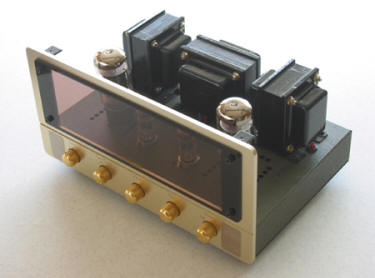
Tokyo Sound SE 100 -integrated tube amplifier
This gave me the music in a mind-blowing way and I really miss it. Maybe I should have sprung for it, but alias, I did not. Am I regretting that I didn't buy it—you bet I am! This little amp has real guts when it comes to driving regular off the shelve speakers (say 89dB sensitivity, it is not necessary to go for the super high efficiency types), with more control than you might think when you read the specifications—8 watts. Well, don't let that low power rating fool you, with the right type of music; vocals and small combos, chamber music, or solo instruments—especially guitar for me, this amplifier delivers the goods! And doesn't use any exotic tubes that cost a fortune, just the standard 6L6 GT that can picked almost anywhere they sell tubes. It should be better known and more promoted than it has been, because it has the magic! What a great concept and execution! (review)
|
Ed Morawski |
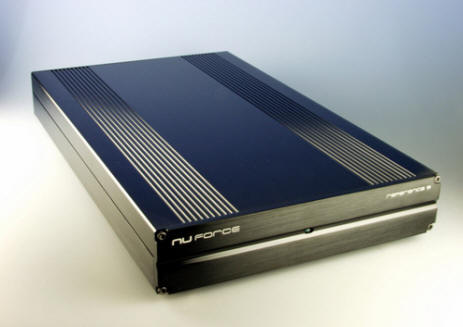
Nuforce Reference 9 Digital Amps
I choose the Nuforce Reference 9 mono-block amps for my choice as best reviewed product for the year 2005 for a few reasons:
-
Great, musical, smooth, delicious sound.
-
Fantastic bass reproduction and control
-
Marvelous resolution without a hint of harshness or brightness
-
Excellent value for the money.
The Nuforce Reference 9s represent the new benchmark by which all digital amps should be measured. (review)
|
Marshall Nack |
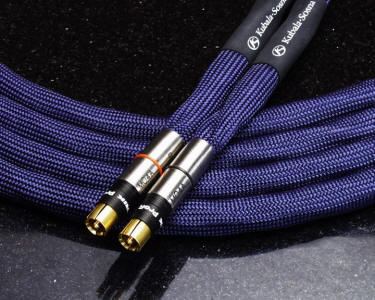
Kubala–Sosna Emotion Cables
I've been playing with some very good cable designs lately, mostly from Audio Note Japan and Harmonix. So I was caught off guard when I put in the top-of-the-line Emotion Series cables from Kubala-Sosna--caught off guard and taken aback. I had just upgraded my wires and now here I was confronted with a new cable that was speaking my lingo and getting the dialect very right. The K-S Emotion preserves the strengths of contemporary gear—accuracy and resolution—while humanizing the portrayal. The naturalness of their full-bodied, weighty and harmonically complete response speaks true. K-S is a quiet company—they don't like to blow their own horn. Consequently, while they're not well known yet. I'd recommend you give them an audition if a richer, correctly balanced frequency palette, is what you're looking for.
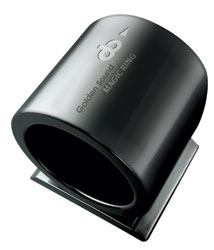
Golden Sound Magic Ring (Small $180, large $300)
The Golden Sound Magic Ring is kin to their Intelligent Chip, albeit not as notorious. Both products are based on the same principles of operation and do similar things. Aside from the reduction in mechanical strains and edginess, I hear significant expansion of the recorded space in terms of definition, layering, and TRUE reverberence effects (not the manufactured ones some gear introduces which pollutes everything you play). The MR does not clamp down on dynamics or constrain them in any way. Consumer caveats apply as with the Intelligent Chip (principally, the treble will be shelved down a bit), and results vary with different wire brands—power cords seem to benefit the most. I demonstrated the MR reliably and repeatedly in three high-res systems. As more than one listener said to me, "They do everything that pushes the audiophile buttons." (review)
TAOC TITE-35S Super Insulator ($295/set of 4)
Wow. I really shouldn't be surprised. These component or speaker
supports from TAOC worked as expected—only better. The TAOC TITE-35S
threw into play an enormous amount of weight and low-end, rock-solid
image placement, and such natural timbral balance—‘twas neither dry nor
lush—they just seem to reveal what's in the source. Easily among the
best I've heard at a fraction of the price of the ones I'm currently
using. Everybody should have a set or two of these graded cast-iron
footers. (review)![]()
GE Silicone II (Small tube $3.25)
This is my tweak of the year. I'm not sure where the idea came from. I was trying to find a cable support that was both functional and sounded good. None came to mind. I already have Polycrystal, Mapleshade, and several others on hand—what else could I buy? Hey, why should I have to buy something else? Here's something that works that you can make with what you already have. Apply a liberal amount of GE Silicone II glue filler to the underside of the Polycrystal Cable Tower to partly fill in the gap. Now float your cables. You will notice a slight reduction in air on top, but you'll be shocked at how extraneous noise is purged and how solid, weighty and focused images become. Silicone has a damping effect—be careful to apply it only where it won't come into direct contact with the cable. I imagine lots of other substances, like wood filler or carpenters putty, would yield intriguing results as well—this is fertile ground (manufacturers, take note). I also treated the joint where the Mapleshade Triad Cable Lift legs come together—this turned out to be the best cable support yet.
|
Bob Neill |

Nitty Gritty 1.5Fi Record Cleaning Machine
Back in the mid 1960's, we drove a Volvo 122 S station wagon. For 160,000 miles. I consider the Nitty Gritty the 1966 Volvo of record cleaning machines. Like my '66 Volvo, I like the Nitty Gritty machine's simplicity, the amount of hands-on involvement it requires. A simple, effective machine for cleaning records that has a utilitarian look to it and that costs what I consider a reasonable sum if you have a growing collection of used LP's. All of the records I have cleaned with it sound noticeably better. In a few cases I have been surprised at how much better. The improvement, in addition to a reduction in surface noise on notably dirty records, is mainly an increase in the traditional analogue virtues: more natural clarity, physical presence of instruments, and ambient information. A very good machine and a great value. (review)
|
Jeff Parks |
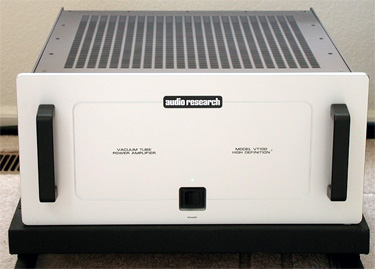
Audio Research VT 100MKII
Wow! What can I tell you…? For the past year and a half I have personally owned the VT 100MKIII which for me according to my audio buddies is a long time. Why do I change gear so often? Like so many audiophiles I have been on a quest for the best sounding musically matched audio system I can afford. Attention everyone! Here is where I am standing on my soapbox. I have to tell you (for me) the buck stops here. While $6500.00 isn't chump change for a piece of audio gear, I believe the VT-100MKIII is an audiophile "best buy." Where else can you have robust bass, and I mean deep authoritative bass not sloppy bass that so many tube amplifiers can be guilty of reproducing. Not only is the bass of the VT-100MKIII superb, so is its soundstaging which with the right gear it can be gigantic. Now here's the kicker with the speed and precision that the VT-100MKIII demonstrates one would think they're listening to a solid state pure Class A amplifier. The VT-100MKIII is that good.
Now don't get me wrong the VT-100MKIII doesn't sound like a typical tube amp nor does it error and venture to sound like a solid state amplifier. Based upon the multiple amplifiers that have graced my sound room over the years, I believe the VT-100MKIII is Audio Research's best effort to date with the VT series of amplifiers. Here is an amplifier that will keep up with the big boys, doesn't sound "tube bloated or solid state dry", rather it presents the music in the most neutral presentation that I have heard to date. Maybe that is why it still has a place in my sound room as my current reference and the reason why I award it my 2005 Positive Feedback Online's Writers' Choice Awards for power amplifiers under $10,000.
Dodson 218 DAC
Over a year ago I contacted Ralph Dodson regarding the highly reviewed Dodson 218 DAC. At the time I was looking to upgrade and replace my modified (though dated) PS Audio Ultralink II DAC. Right way once I placed the Dodson DAC my system took on a new found aural picture when listening to digital. As usual Dodson DACs are known for deep bass production which is spectacular, throws out a huge soundstage, however, what got me was how the 218 gets the music right with analog like precision and air. Notes seem to hang on forever like in the "live" environment or really good analog production. In fact, it is how close the Dodson approaches analog sound that is the greatest redeeming quality of the Dodson DAC (Isn't that the goal of all DACs?).
What sets the Dodson apart from other DACs I have auditioned is the Dodson consistently sounds so good that for the last year I preferred to listen to it as opposed to my VPI Aries with a JMW 10.5 arm, and Benz Micro arm combination. I'm not saying the VPI Benz combination sounds bad, quite the contrary, it sounds great. However, the Dodson comes so close to my analog reference rig that based upon the ease of use as compared to analog, digital for most of the time for my listening sessions just makes more sense. It wasn't until recently when I upgraded my VPI Aries to an Aries II with a Lyra Helikon cartridge did the VPI start to challenge my current recently factory upgraded Mark Levinson Model 37 and Dodson combination. Maybe the reason for Ralph's DACs sounding so analog like is when building and designing the Dodson 218 he doesn't voice his DAC against other state of the art DACs he voices it to challenge analog. To this end I believe Ralph Dodson has met his goal, and is why I am awarding the Dodson 218 my 2005 Positive Feedback Online's Writers' Choice Awards in the category of Digital reproduction.
Marigo Phono Dots
Having a pretty good analog rig which includes, a VPI Aries II, and VPI 10.5 arm, a Lyra Helikon, all powered up by a VPI SDS line conditioner A/C stabilizer sitting on top of a Townshed Seismic Sink and five shelf Seismic Sink Stand, I thought I was done messing with my analog rig and resonance control. I really believed that was as far as I could go with the improvements. Then low and behold one of these $2.00 dots were sent to me. Now there is something anyone can afford.
For about month the little Marigo dot sat on my rig with the intention of eventually placing it on the cartridge body of my Helikon. Now that my Aries is finally dialed in, I thought what the hell it couldn't hurt, so I gave it a shot. Immediately, I heard a difference. I am now hearing a more pronounced soundstage, with less background congestion, and what now appears to be a more focused vocal and instrumental presentation without any loss to the musicality of my rig. If anything my analog rig is more musical and "analog" than ever before. It appears Dave Clark is no longer nuts (Sorry, Dave for ever doubting you!). Upon further hindsight it appears Dave may be a wise man after all since he has been using these products for over a number of years prior to my personal experience with these little gems. (review)
When something can make a huge difference in how one's rig sounds bringing it toward a positive direction and then do it for just a few dollars as opposed to thousands of dollars, I call that an audio bargain! Dave I get it now! Ron you have made me a believer in this application of controlling resonance. Thanks for the dot. Any improvement in my rig is ALWAYS welcome. Let's talk more about me acquiring more of these little gems, now you have my attention. Winner for the best budget price accessory in audio bar none!
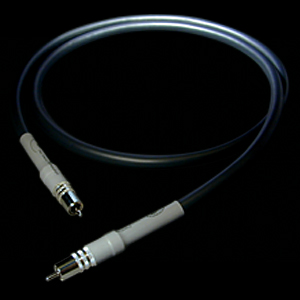
Cardas Golden Reference audio and speaker cables
Over a year ago I embarked on a journey to find the "perfect cable." Since that time I have listened to several offerings from various manufacturers. While most were good, none struck me like the Cardas Golden Reference cables with their uncanny ability to let the music through with the least amount of coloration or sonic signature. I know there are a lot of us audiophiles and especially reviewers who over use the word neutral, and I am not saying the Cardas cables are perfectly neutral; yes they do have a sonic signature where the signature errors on the warm side of neutral. The Golden Reference cable sounds like no other Cardas cable that I have heard to date, it has incredible bass response, excellent midrange, superb high end resolution with ever sounding bright or etched if any thing the cable errors on the side of warm. In addition, I find these cables a perfect match for my Audio Research based system where they bring out the best of my gear. Now here's the kicker whether you are running a long length like mine (7.5 meters) or as short as one meter the cables are unaffected and sound exactly the same. These cables are my personal favorite at any price, hence, the reason for me giving them a 2005 Positive Feedback Online's Writers' Choice Awards in the category of audio cables. Long live George Cardas and the Golden ratio! (review)
Sound Application Reference Linestage Line conditioner
Being one who felt that line conditioners were just a bunch of over priced capacitors and resistors wired in series to create some sort of A/C filter I have never been a fan of line conditioners. Why? Although most clean up the grunge in the A/C line it is usually at the sacrifice of limiting the dynamics of our power amplifiers when they are plugged to the line conditioner. Not with the SA Reference Linestage! Dynamics both macro and micro improved significantly to the point that I never realized my system could achieve. Not only did dynamics improve, so did the sound stage where got bigger and deeper, instrument imaging took on a new found ease that so sounded so real it was almost intimate. Now here is the kicker, now matter which system I placed the Linestage within the improvements were all the same—improved imaging, darker black backgrounds, larger and more realistic sound-staging, and most importantly that ever elusive—dynamics. Be it a solid state, or tube based systems the results were the same as described. In home theater applications video production improved as well with a sharper picture and more vivid colors. No wonder Jim's line conditioners are the product of choice for MoFi, CBS studios, and many reviewers. Truth be told the Sound Application Reference Linestage Line-conditioner made such a difference in "my" system it was almost revolutionary. Maybe that is why I bought my review sample, thus, earning a2005 Positive Feedback Online's Writers' Choice Awards for best audio accessory. (review)
|
Albert Porter |
My choices the 2005 Positive Feedback Online's Writers' Choice Awards are two brand new, recently introduced products and a well-established statement product that I just added to my own system.
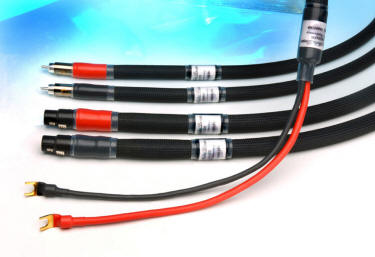
Purist Audio Design 20th Anniversary
Perhaps the most exciting are two stunning new lines of cable from Purist Audio Design in celebration of their 20th year of business.
First is their new flagship, The Purist 20th Anniversary, a statement product that exceeds all previous models in both performance and price. Second, is the reintroduction of Aqueous (the first cable ever built by Jim Aud) as Aqueous 20th Anniversary.
Both products employ new technologies that have been in design and testing for many years, including hybrid metal conductors and a new shield named Contego. Contego refers to the proprietary fluid plus Ferox type particle configuration in separate compartments achieving the ultimate in midrange fluidity combined with superior signal to noise ratio and excellent dynamic capabilities.
Suggested retail price for the Aqueous, 1 meter pair of RCA is $900. The Purist Anniversary, 1 meter pair of RCA will be $8000.
My listening tests are limited as these cables have just arrived, but I will go on the record right now by saying The Aqueous are exceeding the performance of many cables priced multiple times their $900 suggested price.
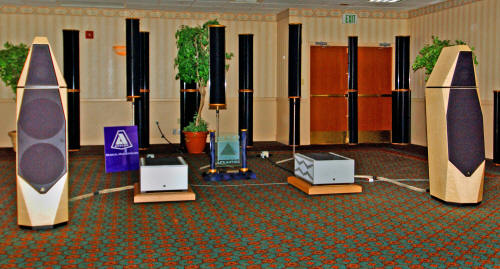
The Avalon Isis
The Avalon Isis is a product so new, it was just introduced to the world a few weeks ago at The Rocky Mountain Audio Festival in Denver, CO. I have always respected Avalon and the Eidolon Diamond has always made a good showing, even with typical poor show conditions. The Isis sets new standards, not only for Avalon but also for high end speakers in general. During my short audition, I was particularly impressed with the Isis huge soundstage and tremendous dynamics and look forward to hearing them under better conditions.
The Isis features a new Black Diamond tweeter (Accuton) that's the same lineage as the Eidolon but with 26% larger diaphragm. Avalon modifies the 7" inch Ceramic midrange (Accuton) for this model and the two 13" inch woofers are a coauthored design between Eton and Avalon. In a never-ending line of firsts, this is I believe, the first all Neodymium driver loudspeakers ever built and should soon be acknowledged as one of the finest speakers available.
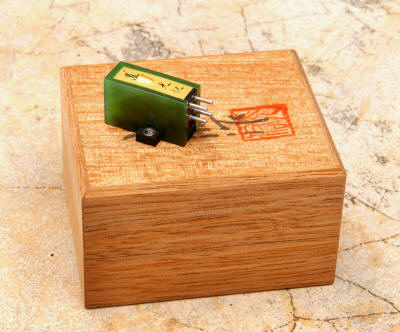
The Koetsu Jade Platinum
Koetsu is an old name in audio and not unfamiliar to me, as the Koetsu Rosewood Signature Platinum has served as my reference for years.
The Jade does everything the Rosewood does but with greater vitality and presence and all the while sounding so effortless and graceful, it redefines what one should expect from state of the art. Never has a phono cartridge achieved this level of performance while intruding so lightly into the mechanical realm. The Jade allows you to slip away and exist only within the music, the ultimate compliment for any component.
Each of these superbly crafted high end products represent the current state of the art in audio today, and although my choices are mostly at the higher end, music lovers today have more high quality choices (at every price level) than ever before. 2005 should be remembered as the year that advanced both the art and enjoyment of music.
|
Chip Stern |
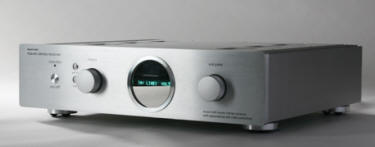
Music Hall Maven Stereo Receiver ($1499)
As an importer/distributor and a manufacturer in his own right, time and time again Roy Hall has staked out the liquid cherry center of value and musicality, pursuing a vision of practicality and performance which owes little to the received wisdom and persnickety conceits of audiophiles save for his insistence on authentic high end resolution. The 100 watt/channel Music Hall Maven harkens back to retro values of audio's earliest days, a modern stereo receiver combining a smooth sounding, effortlessly dynamic integrated amp and an excellent tuner section with such post-mod features as 24-bit/96kHz upsampling and video switching. Yes, yes, for some of you separates are the only way to go—but what of the rest of us? The Maven is a sexy, sensible, sumptuous centerpiece for a solid, cost-effective high end audio system, and will stand proudly next to comparable gear costing twice the price.
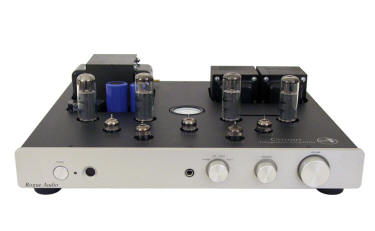
Rogue Cronus Integrated Amplifier ($1795)
Audio designer Mark O'Brien has an authentic passion for music, and as such has dedicated himself to serving the longings of audiophiles whose aspirations often far exceed their pocketbooks. Alas, I must confess that the Rogue Cronus Integrated Amplifier's suggested retail price of $1795 really doesn't represent a fair or representative price—something along the lines of $2895 would be more in keeping with degree of performance value built into this rhythmically nimble 55 watt per channel EL34 equipped integrated with its richly layered midrange and tautly controlled bass (well, a remote control costs you and extra $100, so O'Brien hasn't completely taken leave of his senses). In hearing how effortlessly the Cronus controls loudspeakers, the depth and liquidity of its midrange, its complete lack of stress or strain in reproducing music, one must take pause, step back, and reconsider anew all of those long held beliefs, canards and relative performance parameters often attributed to solid state and tube amps.
Naim n-Sats/n-Stand/n-Sub ($1350 - $2850)
Perceived (or actual) value, as in how closely a product cleaves to key aspects the venerable price/performance ratio, is often the bottom line in determining which way a consumer will go in weighing their final purchase decisions. However, there are practical considerations, such as severe limitations in set-up/acoustic space, which often dictate compromises. Known both for their dedication to quality and their willingness to take unconventional approaches to design, I was quite taken by Naim's take on that old standby, the satellite/sub-woofer system. Originally designed for Home Theater enthusiasts, I was quite taken by the expansive soundstaging, natural detail and clarity Naim achieved with these diminutive, free-floating speakers (cleverly suspended from behind on their slot loaded, curved aluminum n-Stand) in tandem with this very focused, natural sounding, remote controlled sub-woofer (allowing the two-channel listener to zero in effortlessly on the right amplitude and crossover points). Simplicity and musicality incarnate, in an elegantly configured design.
Aural Acoustics Model B ($4500)
The highways are littered with the bleached bones of speaker designers much older and more experienced than Spencer Clark, scion of an audio retailer, who having heard countless loudspeakers over the course of his short life, developed some very definite ideas as to what design principles best suited a high performance/high value loudspeaker. The proof is in the listening. I was not really prepared for the exceptional linearity, full-bodied frequency extension and natural voicing of Clark's three-way floor-standing Aural Acoustics Model B. Incorporating as it does, some of the finest transducers available (including the SEAS Millennium tweeter), Clark employs harmonic time alignment and a phase coherent crossover network with a staggered phase coherent driver alignment—and his own patent pending AccuRange technology (which the designer claims to dampen and absorb the rear wave characteristics of a driver to eliminate cabinet colorations). Very involving and non-fatiguing, the Model B sounds much bigger than its size, is very musical and well worth an audition.
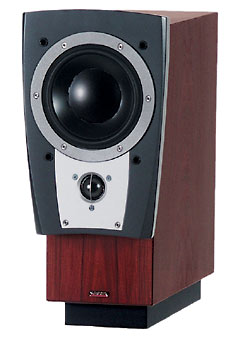
Dynaudio Confidence C1 Loudspeaker ($6500)
The Danish speaker designers are world-renowned for their innovative, superbly built driver components and sophisticated full frequency tower designs. And while most audiophiles naturally gravitate towards big, room-rocking, multi-driver designs, I've always been drawn to the coherence, detail and intimacy of a good two-way mini-monitor—particularly apt for recording and mastering purposes, but often overlooked for dedicated two-channel and multi-channel applications. Now along comes the Dynaudio Confidence C1 Loudspeaker, a true high end mini-monitor (the speaker bolts on to its own dedicated stand), featuring a deep yet slender, small footprint cabinet built along the lines of a small tank, and featuring Dynaudio's finest transducers. Designed from scratch to function as compact no-compromise transducer systems in two-channel or multi-channel systems, the Confidence C1 achieves levels of sonic purity and dynamic veracity which must be heard to be believed—the C1 simply disappears, and all that remain are you and the music. Magical.
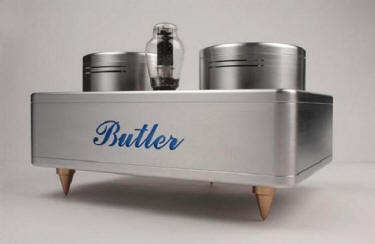
Butler Audio Monad A100 Class A Power Amplifier ($18,000)
Audio designer B.K. Butler has often found himself drawn inexorably to those roads less traveled, and over the course of several years, has defined, refined and implemented a unique approach to modern amplification that seems to sum up the best performance characteristics of solid state and tube technologies in one amp. Been there, done that, right? Well, every time I have encountered the various versions of the Butler A100 Class A Power Amplifier (now dubbed the Monad in its final production iteration) over the past year or two, I've been caught short for words to describe its visceral yet alluring sonic signature, the taut steely focus of an output transformer-less, no global feedback design, with a venerable 300B vacuum tube smack dab in the middle, ostensibly mirroring the SS output stage, directly interfaced to the mechanical electrical speaker load. Huh? Butler claims, as I understand it, to be running the tube thermionically, enabling it to be driven in a zero bias, saturated condition. Oooooo…k—color me befuddled. All I know is it sounds amazing, warmly expansive with unimpeachable dynamic immediacy, a silk glove on a steel fist—like an SET amp on steroids.
|
Fown-Ming Tien |
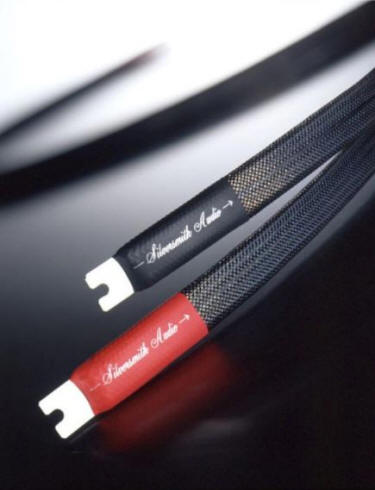
Silversmith Audio Palladium and Silver cables
The Silversmith cables accomplish what all cables should but don't do and that's get out of the way of the music. Jeffrey Smith's design goals of reducing skin-effect to the lowest possible levels enable the Silversmith products to deliver the goods with the least amount of smear, therefore allowing music to flow through as true to the source with more texture, emotion and tonal nuance like no other cable I have heard before. The amount of improvement these cables made was on the magnitude of a component upgrade. (review)
VH Audio AirSine Power Cord
Chris VenHaus' AirSine power cord is a power cord that imparts the least amount of coloration and sonic signature to the sound. By ridding the presentation of subtle and not so subtle veilings, music is brought to life with more organic detail and emotion that nearly every other power cord in comparison sounded as if it was sucking the life out instead.
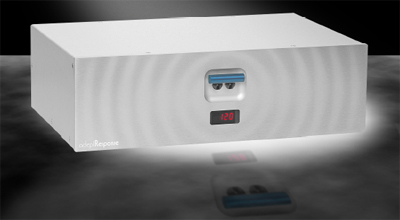
Audience adeptResponse power conditioner
The Audience adeptResponse is perfect in every way. With its gorgeous silver cabinet, it gets a ‘10' for looks. With enough outlets to power even the largest of systems, it gets a ‘10' for practicality. And lastly, with its ability to improve the sound of every piece of gear that I plugged into it, it gets a ‘10' for functionality. Not inexpensive at $3800, but worth every penny. (review)
Eastern Electric MiniMax Phonostage
As the name suggests, the Eastern Electric MiniMax phonostage is small in size, but not small in sound. With prior personal experience with only two of the absolute best phonostages available, I can say without reservation that the $1499 MiniMax takes a back seat to no one regardless of price. With a musical and engaging sound that keeps up with some of the best around, this overachiever delivers the goods. The saying "good things coming in small packages" does not just apply to jewelry although the cute little MiniMax could qualify as an audio jewel.
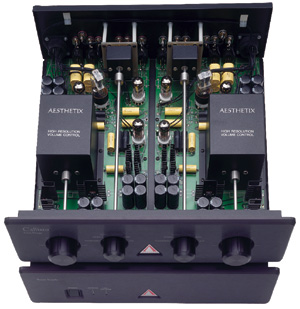
Aesthetix Callisto Signature linestage with single power supply
Arguably one of the best tube linestages available, the incredible $11K Aesthetix Callisto Signature is not just neutral and transparent. It also delivers incredibly dense and full images as well as both wide and deep soundstages. To top it all off, it delivers unbelievable dynamics. When music flows through this rack hog of a preamp, it comes to life more vividly and powerfully than ever before. This is what I call truly large and in charge!
|
Greg Weaver |
Audience adeptResponse Power Conditioner
Not only is the new Audience adeptResponse power conditioner, first unveiled at CES 2005, one of the most extraordinarily effective devices of its class, it is drop-dead gorgeous. With its grained and satin anodized aluminum silver finish (a black finish is also available), sporting its commanding, low resistance, heavy duty magnetic circuit breaker power switch just above the gleaming front panel digital LED displaying the incoming voltage readout, it looks as much like a scientific test instrument as it does a piece of modern art. And, this is the first product I have auditioned since the Grand Prix Audio Monaco Modular Isolation System, which was one of my two Writers' Choice Awards for 2004, that has afforded such a dramatic system wide improvement.
Mine arrived in mid-January and from the instant it went into service, it has been an unparallel delight. I have never experienced a more dramatic improvement from a conditioner. Quieter, darker backgrounds, more vibrant, lifelike images with cleaner edges and enhanced depth and width, more detail, yet less glare, greater dynamic contrasts (both macro and especially micro), cleaner harmonic structure, heightened pitch definition, more fully realized and complexly textured overtones and more warmth to timbre. List an attribute you would expect to have from your power conditioner, and this one actually delivers.
This astonishing product is a no-brainer for this award. In fact, it would surprise me greatly to find that I am alone in honoring this product with my Writers Choice Awards this year. In fact, our own Fown-Ming Tien has recently published his experiences with this magnificent instrument.
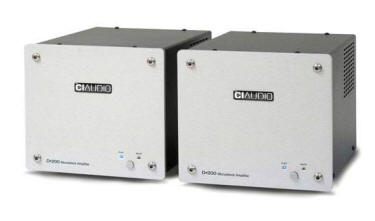
Channel Islands Audio D-200 monoblock amplifiers
If you are foolish enough to dismiss an amplifier that weighs in at a trifling 15 pounds and displaces only about one sixth of a cubic foot per channel as not worth your time, then the joke is on you! Over the years, there have been many amps that have delivered the lion's share of "Super Amp" performance for some fraction of the price. Yet they have all had their shortcomings, enough so as to bear out the old aphorism that there is no such thing as a "free lunch." Channel Islands Audio has created the first true amplifier GIANT KILLER. Designer Dusty Vawter has beaten the adage!
The D-200s have a full, rich flavor that is very akin to "tube" sound, but with significantly less coloration. They are warm and lush, harmonically rich and vibrant, yet extraordinarily detailed. Lows are tight and extraordinarily fast, and are blended seamlessly with the luxuriant mid range and treble. And the lowest to highest frequencies are all reproduced with complete tonally coherence.
Image depth is quite accurate, no more nor less than what I've come to expect from many expensive amps like the VAC Phi Beta or the darTZeel NHB-108 model one (both about $19,000), and sound stage size is remarkably large, wide and deep. They will play loudly without strain or distortion, seemingly well beyond what I have come to expect from a 200-wpc device, and they just don't get glassy at high volume levels. They posses none of that "sterile" quality some highly regarded solid state amps offer. In fact, they sound very much like live music.
This UNRIVALED class-D amplifier is a hands down winner; and not only in the "for the money" category. It may in fact be the best sounding amplifier I've ever heard! No foolin'. In fact, I can relate a tale of one music lover (David, are you reading this?) who, upon my recommendation, put them up against a $10,000 "super amp." And, the $10K entrant went back to the manufacturer! Watch this space for my full review, hopefully finished and up around Thanksgiving.
|
John Zurek |
My choice for the 2005 Positive Feedback Online's Writers' Choice Awards? There was no choice. Of all the components I've had in house this year one stood out so far from the rest it was obvious. The VPI Scoutmaster Turntable with JMW-9 Tonearm. Easy to use and set up, sound that excites, and evokes emotion, the Scoutmaster jumps right out of the way of the music. Resolution of low-level detail was killer. The overall portrait had energy and transparent neutrality. Imaging was solid, and projected a huge soundstage that was evenly rendered from front to back and from sidewall to sidewall and beyond. Well-paced, with impressive low and high-end extension. Gone are the days of the polite-sounding, slightly thick, slightly slow VPIs. This is the new generation. It boogies. Competitive with much high priced models, the fact that your $2400 includes the JMW-9 Arm makes it a ridiculous bargain. I can't think of any way to spend this amount of money on your system and get so much payback. (review)

